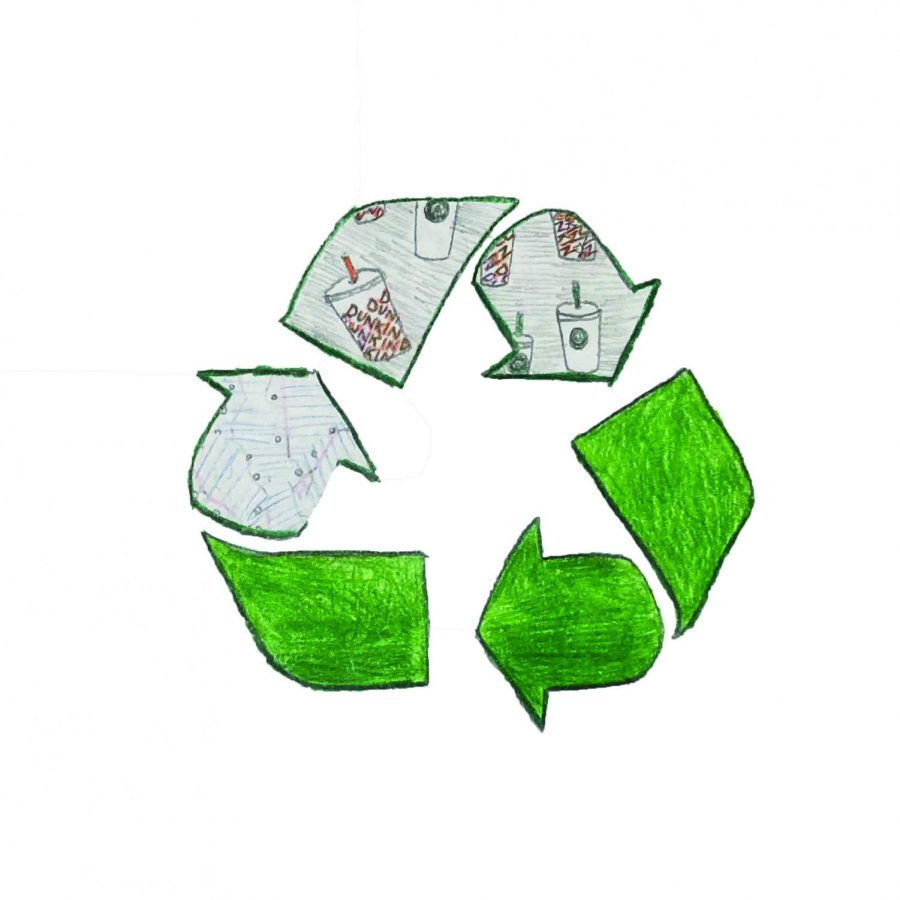Neshaminy High School Recycles!! Who Knew??

Recycling logo drawn by Brynn Simon
February 15, 2019
The end-of-period bell rings, you grab your Dunkin’ cup off your desk – ignoring the last bit of watered down coffee in it – tossing it in the trash, or the green bin directly next to it, on your way out.
Though that little bit of watered down coffee makes it trash, if you finish your drink, or wash it out, the container is actually recyclable. Better yet, if you purchase a reusable Dunkin’ Donuts or Starbucks cup, there are certain discounts given, such as 10 cents off, a free doughnut, or giving you the next size up for the price of the size you ordered. For days that you’re studying in a Starbucks cafe, they offer in store “for here” mugs to use so you don’t have to waste a paper cup– beneficial for both you and the environment.
At the end of each day, the janitorial staff at Neshaminy High School collects all of the trash and recycling, sorting out the clear recyclable bags and the black trash bags at the dumpster and large recycling bin outside of gym 3. If the janitors see that there is more food than recyclables in the clear bags, they will throw it out with the rest of the trash, saving the time of the waste management and recycling Neshaminy pays to sift through the recyclables. Neshaminy does in fact recycle, however, it’s up to the students and staff to deem it’s worth paying to do so.
“Recycling at the High School is misunderstood and often neglected,” AP environmental science teacher, James Maloney, claims. “Recycling cans and trash cans are different. It is not possible to put trash into recycling cans and expect it to be fine. If we contaminate our recyclables with trash, the entire bag is no longer recyclable.” When asked if any other staff members beside the environmental teachers promote recycling, Maloney explains that within Neshaminy “there isn’t a huge movement, but there are a few clubs that make it their mission. The nature club and the environmental action club both promote more environmental consciousness.”
Maloney further says that it “costs money for upgrades and enhancements”, and in small doses, Neshaminy is working towards becoming more eco-friendly, such as building a greenhouse in the courtyard outside of the art rooms and accepting grants towards other environment projects.
When tossed in the trash, that one cup will end up in a landfill, taking at least 450 years for just the cup to decompose, the straw taking at least 50 more. However, when thrown into the green recycling bin, lined with the clear bag, as long as the cup follows the guidelines of having no liquid in it, it will be recycled. One styrofoam cup takes 50 years to decompose, 200 years for an aluminium can, and 4000 years for a glass bottle; utilizing the free recycling at Neshaminy can help prevent the covering of our planet in trash.
The chemicals that plastic consists of are being burned down in attempt to rectify our over-consumption problem (due to the fact that landfills are overflowing with these toxic products) thus transmitting harmful pollutants into the air we breathe. According to The Guardian, “children who were exposed to high concentrations of phthalates in the womb were 70% more likely to develop asthma between the ages of five and 12”, which explains why the number of people who suffer from asthma has skyrocketed since the sixties. The amount of people who put in orders for prescription inhalers have more than doubled since 1967.
About 14 billion pounds of plastic enter the ocean each year, killing a vast amount of aquatic species. While purchasing a Vineyard Vines shirt does help raise awareness for whales that are going extinct, buying a T-shirt is not as beneficial as recycling, helping end the reason whales are dying. With the amount of trash entering the ocean, there will be no animals left to protect if precautions aren’t taken.
The Great Pacific Garbage Patch is 600,000 square miles (twice the size of the state of Texas) floating between California and Hawaii consisting of 88,000 tons of plastic alone. This could’ve been prevented if more people on Earth recycled. Ecologists claim that by 2050, there will be more trash in the ocean than fish.

